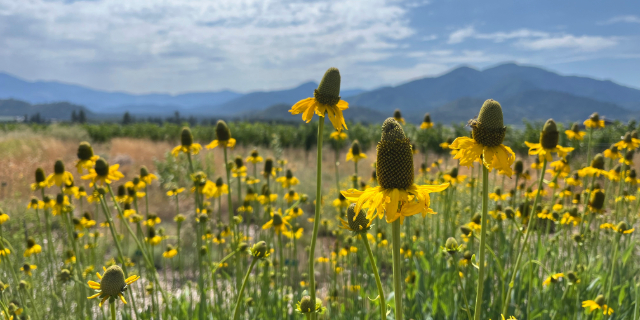GARDEN PLOTS: ‘Onward and Upward’ provides a bit of garden history and advice
Published 6:00 am Wednesday, July 5, 2023

- Katharine White describes Oregon as “famous for lilies,” partly due to the work of lily breeder Jan de Graaff, who hybridized lilies at the Oregon Bulb Farm in Canby until 1960.
“After two years of giving the catalogues an annual going-over … she set to work, onward and upward, exploring other aspects of the garden world: the history of gardens, the literature of gardens, the arranging of flowers, the herbalists, the trends and developments.”
Trending
— E.B. White, about his wife’s gardening columns in “Onward and Upward in the Garden,” Katharine S. White, 1979
All year I’ve been looking forward to reading Katharine Sergeant White’s classic gardening book “Onward and Upward in the Garden,” and I think her husband, author E.B. White (renowned for “Charlotte’s Web” and other popular children’s books), summarizes the focus of her collection of essays quite nicely in the introduction.
Katharine was a fiction editor for the New Yorker from 1925 to 1961, and then enjoyed a second part-time career for the magazine as a garden columnist until her death in 1977. Not only did Katharine thoroughly research the topics of her columns, she also drew from many years of gardening experience at her home in Maine.
Trending
E.B. (which stands for Elwyn Brooks), or “Andy” as he was called by friends, compiled the articles into a book after she died, stating, “[W]hen I got around to reading the articles, I discovered to my great joy that though they began 20 years ago they still seemed fresh … her excitement at growing things, her belief in the worth of gardening, her fascination with the architects who were behind the [seed and nursery] catalogues — these were timeless.”
Now, 43 years after “Onward and Upward in the Garden” was published, these qualities of Katharine’s writing still endure, although the colorful gardening folks she describes are all long gone and many (not all) of the garden nurseries and seed companies are no longer in business. The book is a treasure for anyone interested in gardening history. I’ve been reading with my smartphone beside me so I can look up the people, places and plants she mentions.
Among the plant people she introduces is Roy Hennessey, “Oregon’s angry man,” who ran a nursery in Scappoose and published a catalog called “Roy Hennessey’s Prize-Winning Roses” until 1962. Katharine praises the wide variety of roses Hennessey tested and, if he approved of them, included in the listings of his annual, unillustrated catalogs. (Can you imagine enjoying a seed or plant catalog with no pictures today?)
She remarks, “[I]t is obvious that Roy Hennessey loves roses and cares a great deal about developing those that will withstand heat and resist disease”; however, she expresses less enchantment with his “diatribes” throughout the catalog on subjects that fired him up. Apparently, those subjects included what he called the “floribunda mess,” the American Rose Society, the Jackson & Perkins Company, the state of Arizona, and what he called “eddication” and “eggsperts,” in general.
A more soothing Oregon-based plantsman, according to Katharine, was Romaine B. Ware of Canby. She compliments Ware for growing “lily bulbs of all kinds” and for issuing “the most attractive catalogue I have seen.” She ends her description by noting, “Oregon’s lilies are famous,” but she does not explain why.
Some of this fame undoubtedly stemmed from lily grower Jan de Graaff, who operated the Oregon Bulb Farm in Sandy until 1960. Hailed by the New York Times as “tamer of the wild lily,” de Graaff was a prolific breeder of lilies, including the fragrant Oriental hybrid “Stargazer.” De Graaff is credited for popularizing the use of lilies in home gardens, and Katharine certainly admired his “famous Olympic white lilies” but didn’t care for ‘Pink Perfection,’ “which looks too much like raspberry ice cream.”
The book is filled with interesting historical anecdotes, but Katharine also sprinkles in some practical gardening advice. In a chapter dated Sept. 26, 1959, she mentions taking a census of the number of leaves on her four amaryllis bulbs, grown indoors, “to make sure I am feeding them enough to bring plenty of flower stalks next February and March.”
According to Katharine, who quotes Hamilton B. Traub’s “Amaryllis Manual” of 1958, gardeners should shoot for nine leaves on their amaryllis because this number will produce three flowers, one after each third leaf. (I checked my amaryllis and discovered I now have six leaves, which will give me only two flowers.) To induce more leaves, Katharine recommends moving the plant to a slightly sunnier location and feeding it with a balanced fertilizer. (Will do!)
I am touched by E.B.’s tribute to his wife. Clearly, putting the book together was a labor of love and was probably an important part of his grieving process after Katharine died. At the end of his introduction, E.B. recalls the last fall of her life when, dressed in an old, oversized raincoat, she directed the planting of spring-blooming bulbs from a chair because she was too weak to do the work herself.
“[T]here was something comical yet touching in her bedraggled appearance on this awesome occasion,” E.B. remembers, “…her studied absorption in the implausible notion that there would be yet another spring, oblivious to the end of her own days … sitting there with her detailed chart under those dark skies in the dying October, calmly plotting the resurrection.”
Katharine died July 20, 1977. She did live to see her daffodils, hyacinths and tulips blooming one last time.









